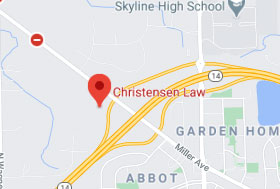
According to the Michigan Office of Highway Safety Planning (OHSP), there were thousands of truck accidents throughout the state in a single recent year. Hundreds of those crashes resulted in serious or fatal injuries. Those who survived may still live with chronic pain, spiraling medical debt, and permanent disabilities due to their wrecks.
Understanding the common causes of Michigan truck accidents is crucial for staying safe and determining who should be held accountable when commercial vehicle collisions occur. Here, Christensen Law provides an overview of the top eight causes of truck accidents in Michigan.
If you or a loved one was seriously hurt in a crash with a semi-truck, tractor-trailer, 18-wheeler, or other commercial motor vehicles, call or contact us for a free consultation with an experienced Michigan truck accident lawyer.
Driver Fatigue
The Federal Motor Carrier Safety Administration (FMCSA) imposes strict hours-of-service (HOS) regulations designed to prevent commercial drivers from driving too long and becoming dangerously exhausted behind the wheel. Unfortunately, truck drivers are often under immense pressure to meet demanding quotas by completing their routes as quickly as possible.
Trucking companies may compel drivers to push themselves past the limit by using monetary incentives or even threatening to fire them. When trucking companies implicitly or explicitly encourage their drivers to ignore federal safety regulations and drive until they are completely drained, truck drivers are more likely to commit preventable driving errors and cause serious accidents.
Distracted Driving
Distracted driving is a common cause of Michigan truck accidents, and the continuing innovations with cell phones and other electronic gadgets are only making the problem worse. Many modern commercial trucks are equipped with global positioning systems (GPS), electronic logging devices (ELDs), and even company cell phones that attract drivers’ attention and make distracted driving accidents more likely.
Texting while driving is a particularly dangerous form of distracted driving. Research commissioned by FMCSA suggests that sending or receiving the average text message diverts a driver’s attention away from the road for approximately five seconds. That’s enough time for a trucker traveling at just 55 miles per hour to cover the entire length of a football field, all with minimal attention on the road ahead.
Truck drivers who text behind the wheel are roughly 23 times more likely to be involved in a “safety-critical event,” such as a crash or near-crash scenario. Other dangerous distractions include eating or drinking, personal grooming, and checking maps or navigation systems while driving.
Driving Under the Influence
Driving a vehicle while drunk or under the influence of certain drugs isn’t just dangerous. It’s illegal. Most drivers are considered too intoxicated to drive safely when their blood alcohol concentration is 0.08 or greater. But for drivers of large commercial trucks, the limit is even lower. Per FMCSA and Michigan trucking laws, truck drivers are considered to be driving under the influence when their blood alcohol concentration is 0.04, half the legal limit for non-commercial drivers.
This lower limit on blood alcohol levels for truck drivers is meant to discourage drinking and driving. However, many truck accidents still occur every year as a result of driving under the influence. The National Highway Traffic Safety Administration (NHTSA) reports that approximately one traffic fatality occurs every 52 minutes due to drunk driving accidents in the United States, many of which involve big trucks.
Speeding and Overtaking
Exceeding posted speed limits and racing to overtake other vehicles in traffic can be dangerous behavior for any driver. But for commercial truck operators, speeding and overtaking maneuvers can cause truly catastrophic accidents. When truckers speed or drive too fast for road conditions, they may put themselves in a position where they do not have enough room to slow down if traffic comes to an abrupt stop.
Large commercial trucks require more time and distance to stop than smaller vehicles, which means traveling at high speeds is especially risky for truck drivers. A truck traveling at just 65 miles per hour can take up to two football fields of space to come to a complete stop, so truck drivers must always pay close attention to the following distance. Truck drivers who weave between lanes or cut off other motorists to overtake them on the road can also cause devastating rear-end or sideswipe accidents due to sheer recklessness.
Poor Driver Training
According to the American Trucking Association, the trucking industry has been struggling with a shortage of truck drivers since at least 2005 for several reasons. Today’s trucking companies are having difficulty finding qualified drivers, which is leading some carriers to cut important corners out of desperation. Many carriers have resorted to hiring unqualified, underqualified, or poorly trained drivers to keep their businesses afloat.
When inexperienced truck drivers with inadequate training hit the road, they put themselves and everyone around them at risk. Inadequate driver training may lead to accidents involving drivers who failed to perform adequate truck maintenance, ignored federal hours-of-service regulations, or made preventable driving errors.
Truck drivers who lack basic knowledge about their rigs and how to handle them frequently cause dangerous crashes. Common examples of accidents stemming from driver inexperience include rear-end collisions, multi-car pileups, jackknife accidents, and cargo spillage wrecks.
Inadequate Truck Maintenance
Commercial trucks haul massive cargo loads across hundreds of miles every day, which means they are subject to persistent wear and require vigilant maintenance. Truck drivers are expected to perform regular inspections and basic maintenance of their trucks while in transit to ensure all truck components are in working order. However, drivers are not solely responsible for truck maintenance.
When inadequate maintenance leads to truck accidents, other parties such as trucking companies and repair shops may be liable. Trucking companies that own large commercial trucks are responsible for providing suitable and safe equipment to their drivers. Mechanics who work on big rigs also bear responsibility for conducting in-depth inspections and recommending or completing necessary repairs.
When truck drivers, owners, or mechanics are negligent in the maintenance or upkeep of a large truck and its components, catastrophic truck accidents can occur. Inadequate truck maintenance may lead to tire blowouts, brake failure, loss of steering control, or other critical system failures that cause serious collisions.
Failure to Obey Traffic Rules
Breaking traffic laws is often closely tied with other types of negligent driving, such as distracted driving or driver fatigue. When truck drivers are negligent, their failure to obey basic traffic safety rules can result in devastating collisions with other vehicles.
Speeding is a common traffic violation among truck drivers who are frustrated behind the wheel or simply attempting to keep up with unreasonable delivery demands. When drivers exceed posted speed limits, they put themselves and others at risk of serious injuries caused by high-speed truck collisions.
Many truck accidents also occur because drivers ignore or intentionally violate right-of-way laws. Truck drivers who cut other vehicles off as they are merging or navigating an intersection can cause rear-end, sideswipe, and underride accidents. Truckers who violate traffic rules by running red lights or stop signs at intersections can cause tragedy when they T-bone other vehicles or collide with them head-on.
Aggressive Driving/Road Rage
Any driver with road rage can be a hazard to themselves and others. But when an aggressive driver is behind the wheel of a colossal 18-wheeler, the risk of accidental injury becomes even greater. Most truck drivers operate professionally and courteously, but aggressive truckers put everyone in danger by making unsafe driving decisions intended to intimidate or harass others on the road.
One common and dangerous aggressive driving behavior is tailgating, which is incredibly unsafe in a large truck that requires more space to slow or stop. Truck drivers who tailgate smaller vehicles can cause serious or fatal injuries in devastating rear-end crashes when they fail to leave themselves sufficient following room.
In rare and particularly shocking scenarios, truck drivers with road rage may even attempt to run other drivers off the road entirely. This frightening tactic can cause other drivers to lose control or veer into other vehicles, creating multi-car pileups.
Contact a Truck Accident Lawyer at Christensen Law
Contact us today for a free initial consultation to discuss your claim’s details with an accomplished Michigan truck accident lawyer.





